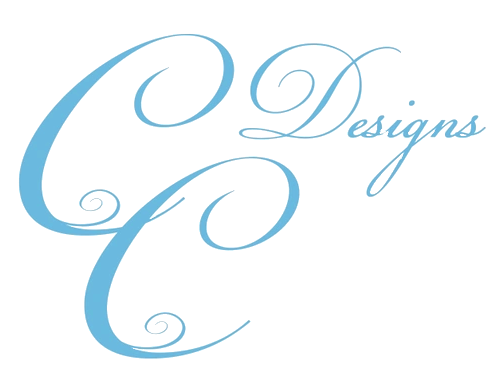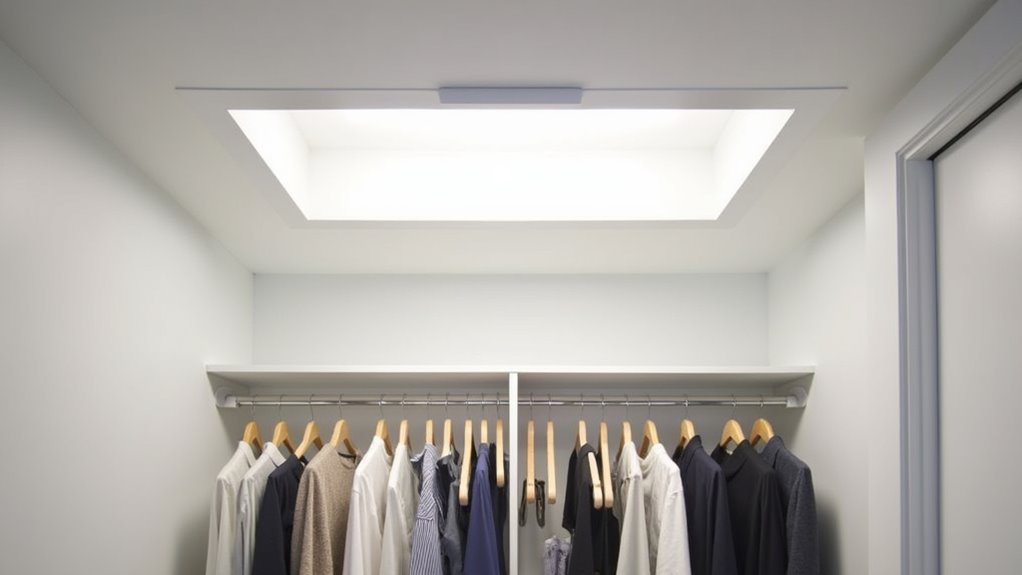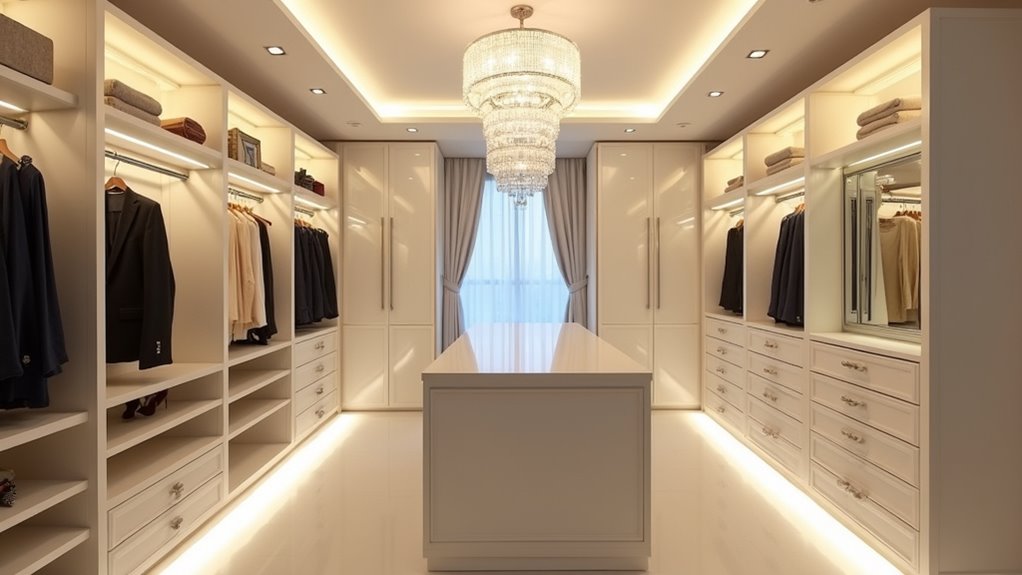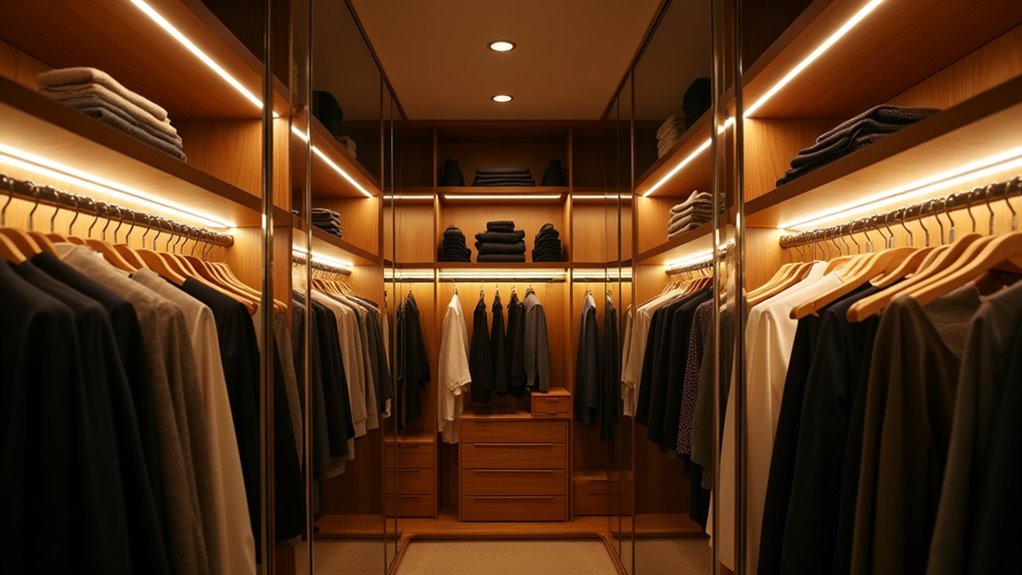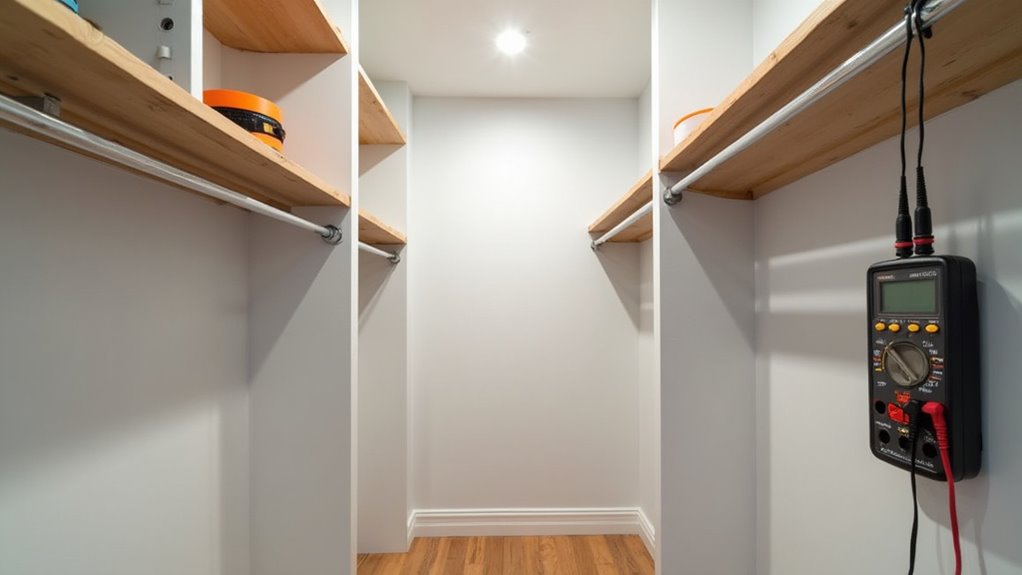You must install closet lighting that complies with NEC Section 410.16, which requires fully enclosed fixtures with specific clearance distances from storage areas. Surface-mounted incandescent or LED fixtures need 12 inches of clearance, while recessed fixtures require only 6 inches. You can’t use pendant lights, bare bulbs, or partially enclosed lamps due to fire risks from combustible materials. Choose fixtures labeled specifically for closet use, and guarantee they completely enclose the light source. The sections below provide detailed guidance on fixture selection, placement strategies, and professional installation considerations.
NEC Section 410.16 Standards for Closet Lighting
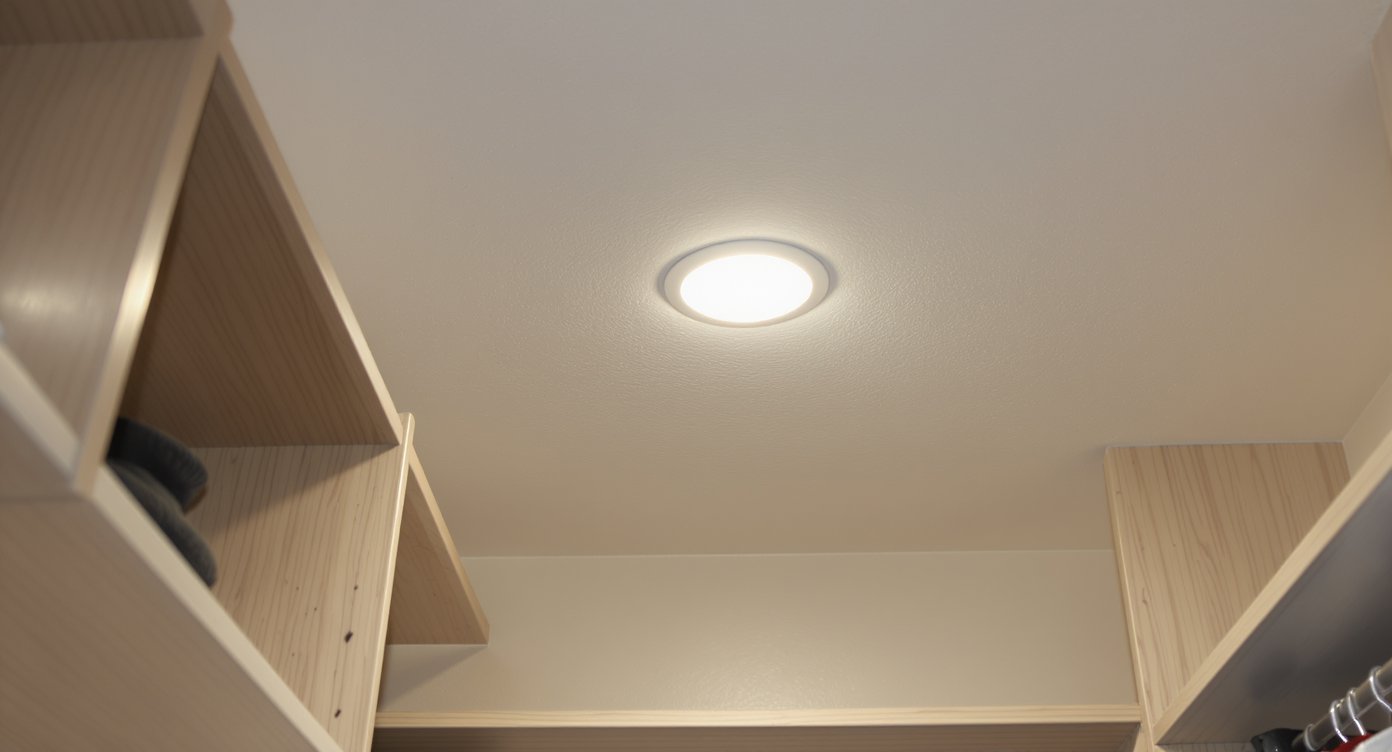
NEC Section 410.16 establishes mandatory standards for luminaire installation in clothes closets, defining both where fixtures can be placed and what types are permitted. You’ll need to maintain specific clearances: 12 inches for surface-mounted incandescent or LED fixtures, and 6 inches for recessed or fluorescent types. Storage space extends 12 inches from walls (or shelf width if greater), creating zones where only closet-rated fixtures can be installed. Your lighting layout planning must account for these distances, potentially positioning fixtures up to 24 inches from walls. Pendant fixtures and partially enclosed lamps are strictly prohibited. You must verify installation signage and manufacturer documentation confirming closet-rating compliance. The storage space definition also includes the volume bounded by planes extending from the floor to 6 feet or to the highest clothes hanging rod. Following these clearance requirements helps mitigate overheating risk from fixtures positioned too close to combustible materials. Fixtures must pass temperature tests with insulation in place to ensure they meet safety standards for closet environments. These fire-safety provisions are non-negotiable; inspectors will require proof that your selected luminaires meet Section 410.16’s technical specifications before approving installation.
Permitted Fixture Types for Closet Installations
You must select fixtures that fully enclose the lamp to prevent ignition hazards from direct contact with stored items. Surface-mounted luminaires, whether incandescent, fluorescent, or LED, are permitted only when labeled specifically for closet installation and provide complete lamp enclosure. Recessed fixtures offer an alternative, provided they incorporate fully enclosed lamps and comply with the clearance and construction standards outlined in NEC 410.16. When installing recessed lighting, adjustable fixtures allow for directional lighting to highlight specific areas within the closet space. Pendant luminaires and lampholders are not allowed in closets due to their exposed lamp configurations that increase fire risk. These requirements help ensure proper visibility and organization while maintaining safety standards in confined storage areas.
Fully Enclosed Light Sources
When selecting lighting for closet installations, understanding which fixture types meet code requirements is critical for both safety and compliance. You must install surface-mounted or recessed luminaires with completely enclosed light sources for incandescent and LED fixtures. The luminaire construction materials must contain the bulb entirely; no exposed sockets or partial enclosures are permitted. Fluorescent fixtures offer more flexibility, as they don’t require full enclosure but must still meet listed standards. Your luminaire output levels should provide adequate illumination while maintaining proper clearances from stored combustibles. NEC 410.16 specifically prohibits bare bulbs, pendants, and open fixtures in clothes closets due to fire hazards from heat generation and accidental ignition. Even when retrofitting existing fixtures, you can’t simply replace incandescent bulbs with LEDs; the fixture itself must be fully enclosed. Incandescent-capable fixtures must be recessed beyond drywall surface or completely enclosed to meet safety standards in closet applications. Surface-mounted incandescent fixtures require minimum 12 inches clearance from any storage areas or clothing to prevent fire hazards.
Surface-Mounted Fixture Options
Surface-mounted luminaires represent the most accessible code-compliant lighting solution for closet installations, offering straightforward compliance with NEC 410.16 requirements. You’ll find three permitted fixture types: completely enclosed incandescent luminaires, LED fixtures identified for closet use, and fluorescent units suitable for enclosed spaces. Each option requires a minimum 12-inch clearance from storage areas when using incandescent or LED sources with fully enclosed lamps.
Your fixture selection must carry proper safety certifications, including UL Closet Rating Test compliance. LED variants deliver superior energy efficiency while generating minimal heat, drastically reducing fire hazards. You can achieve both code compliance and design aesthetics through strategic placement on ceilings or walls. Modern fixture customization options let you specify color temperatures between 3000-4000K, integrate motion-sensing capabilities, and select appropriate lumen outputs for ideal visibility. Installation of ceiling light fixtures is recommended for closets exceeding 50 square feet to ensure adequate illumination and safety. While lighting installation isn’t legally required in standard closets, upgrading to code-compliant fixtures can enhance both safety and home value.
Recessed Lighting Allowances
Recessed luminaires offer improved aesthetics and space efficiency in closet applications while maintaining full compliance with NEC 410.16 safety standards. You must select sealed fixtures with completely enclosed light sources to prevent direct contact with combustible materials. These installation requirements guarantee fire hazard mitigation:
- Permitted Types: Recessed incandescent, LED, and fluorescent luminaires with fully enclosed lamps qualify for closet installations
- Minimum Clearance: Maintain 6 inches separation between fixture face and storage contents
- Junction Box Access: Ensure accessibility for maintenance without disturbing closet contents
- UL Compliance: Install only listed fixtures meeting NEC specifications
LED and fluorescent options provide superior heat management compared to incandescent alternatives. You’ll reduce clearance concerns while achieving energy efficiency. Verify all fixtures feature complete lamp enclosures before installation to meet code enforcement standards. If your closet depth measures exactly 18 inches, position the recessed light above the door as your only compliant installation option. All recessed fixtures must be controlled by a wall switch for proper operation and code compliance.
Prohibited Lighting Fixtures in Closet Spaces
You must avoid incandescent luminaires with open or partially enclosed lamps in closets, as they generate excessive heat that poses significant fire risks near combustible materials like clothing and storage boxes. Pendant luminaires and hanging fixtures are strictly prohibited under NEC Section 410.16 because they can contact stored items and ignite them. Lamp-holders and any fixture without a completely enclosed light source fail to meet code requirements and create dangerous conditions in spaces with concentrated flammable contents. Bare-bulb light fixtures represent the number one lighting fire hazard in closets and must be replaced with approved enclosed alternatives. Fixtures with metal pull chains can become electrified if the base cracks, creating an additional shock hazard in closet spaces.
Exposed Incandescent Bulb Dangers
Exposed incandescent bulbs in closets have ignited countless house fires across the country, making them one of the most preventable electrical hazards in residential construction. These bulbs generate extreme heat that readily ignites combustible materials like clothing, cardboard, and paper through direct contact. Home fire incident statistics consistently link exposed bulbs to property loss and injury.
You’re facing four critical dangers:
- Heat concentration – Confined closet spaces trap thermal energy, accelerating ignition potential
- Accidental contact – Moving items or reaching for clothing brings materials into direct bulb contact
- Extended operation – Forgotten lights left on increase heat exposure duration
- Proximity to flammables – Storage areas inherently contain ignitable materials
While older building standards once permitted exposed bulbs if positioned at least 18 inches from shelves, this distance proved insufficient to prevent fire incidents. Modern codes mandate alternative lighting safety features including completely enclosed luminaires, recognizing that open incandescent fixtures create unacceptable fire risk in storage environments.
Partially Enclosed Lamp Risks
While completely exposed incandescent bulbs present obvious hazards, partially enclosed fixtures create a false sense of security that’s just as dangerous, and explicitly prohibited by electrical code. NEC 410.16(B) specifically bans these installations because they allow hot lamp surfaces direct exposure to clothing and boxes, creating stored materials fire risk. Heat buildup behind closed doors accelerates unintended combustible ignition.
| Prohibited Fixtures | Code-Compliant Alternatives |
|---|---|
| Half-dome covers | Fully enclosed LED luminaires |
| Recessed “eyeball” lights | Recessed enclosed fixtures (6″ clearance) |
| Partial globe shields | Surface enclosed (12″ clearance) |
| Open pendant fixtures | Certified closet-rated luminaires |
You can’t simply add partial shielding to achieve compliance; full enclosure or closet-certified rating is mandatory. Inspectors routinely flag these violations, often requiring replacement before occupancy approval.
Pendant Fixture Fire Hazards
The regulatory rationale addresses multiple hazards:
- Exposed bulbs generate surface temperatures exceeding 150°F, igniting textiles on direct contact
- Fixture movement risks from cords or chains being snagged during storage activities
- Impact vulnerability causes bulb breakage and hot material dispersion
- Electrical arcing from loosened sockets due to repeated physical disturbance
Occupant awareness concerns remain critical; homeowner surveys reveal widespread ignorance of pendant restrictions despite their prevalence in violation reports. Up to 10% of residential closet fires involve improperly installed fixtures, with pendants frequently identified as ignition sources. Non-compliance invalidates insurance coverage and fails inspections.
Minimum Clearance Requirements From Storage Areas
Proper clearances between closet lighting fixtures and storage areas form the foundation of code-compliant closet installations. You must measure these clearances from the storage zone, defined as 12 inches from walls or shelf width (whichever is greater), extending vertically to six feet or the highest rod. These requirements apply regardless of occupancy sensors or lighting controls you’ve installed.
| Fixture Type | Installation | Minimum Clearance |
|---|---|---|
| Surface-mounted incandescent/LED | Enclosed lamps | 12 inches |
| Recessed incandescent/LED | Enclosed lamps | 6 inches |
| Surface-mounted fluorescent | Standard | 6 inches |
Closet-rated fluorescent or LED fixtures may install within storage spaces without clearance requirements when manufacturer-approved. You’ll need to verify UL listings and maintain proper distances for non-rated fixtures to prevent fire hazards from heat buildup near combustible materials.
Understanding Fully Enclosed Light Source Requirements
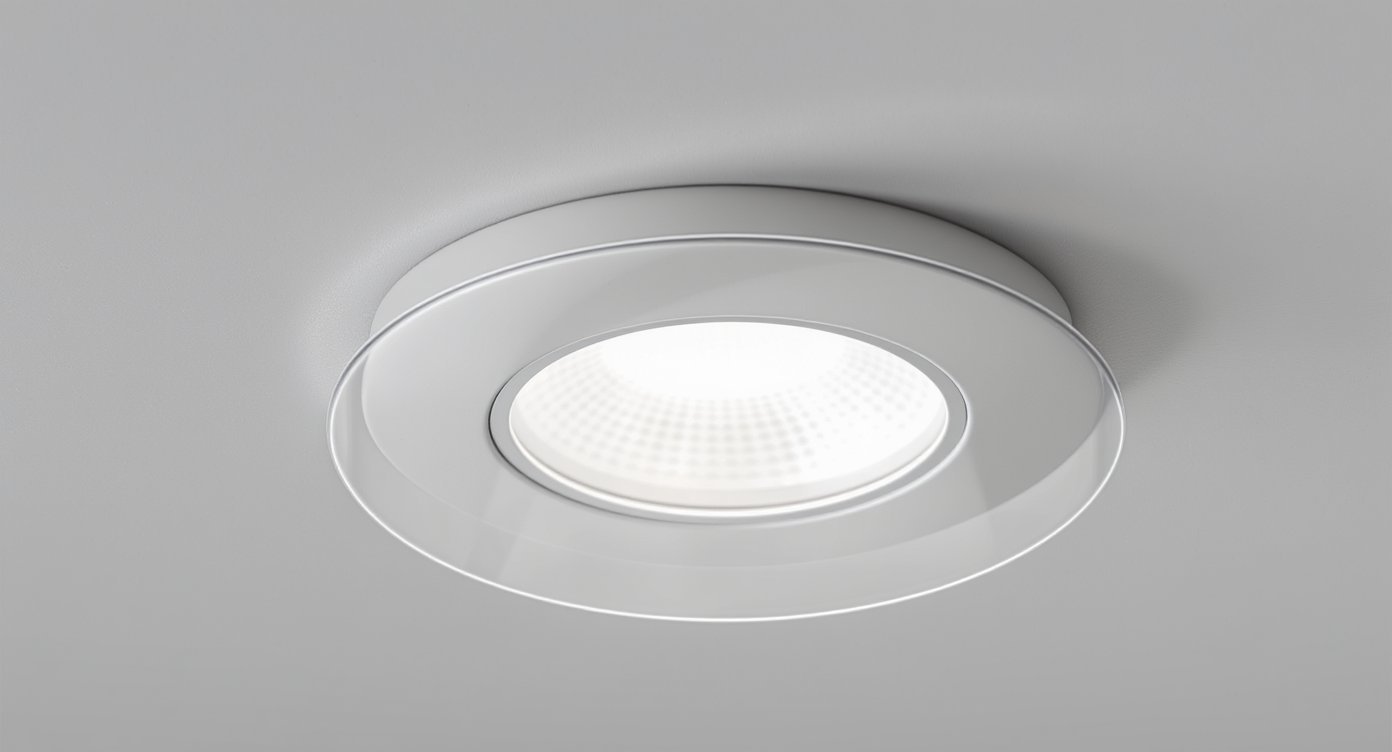
- Surface-mounted or recessed incandescent luminaires with complete lamp enclosure
- Fully enclosed LED fixtures unless specifically rated for closet storage areas
- Surface-mounted fluorescent luminaires (enclosure not required per code)
- Manufacturer-certified “closet-rated” LED or fluorescent products with explicit NEC 410.16 compliance labeling
Open bulbs, pull-chain fixtures, and pendant lights are prohibited. Heat containment and breakage protection are critical, even energy-efficient LEDs require enclosure unless marked closet-suitable by manufacturers.
Fire Hazard Risks Associated With Non-Compliant Fixtures
Non-compliant closet lighting creates immediate fire hazards when fixtures generate excessive heat near combustible materials. Exposed incandescent bulbs can ignite clothing, cardboard, and wrapping paper stored within 12 inches of surface-mounted fixtures. You’re facing electrical overload risks when non-listed fixtures operate in enclosed spaces, raising ambient temperatures and lowering ignition thresholds. Pull-chain and pendant fixtures increase flame propagation concerns due to exposed bulbs moving closer to stored items. Even LED fixtures present hazards if they’re not fully enclosed and closet-rated per NEC requirements. Accumulated dust on bulbs intensifies overheating, while extended operation periods in unmonitored closets compound risk. Insurance claims are frequently denied when closet-originated fires trace back to code violations, making compliance essential for safety and liability protection.
Benefits of LED and Fluorescent Fixtures for Closet Safety
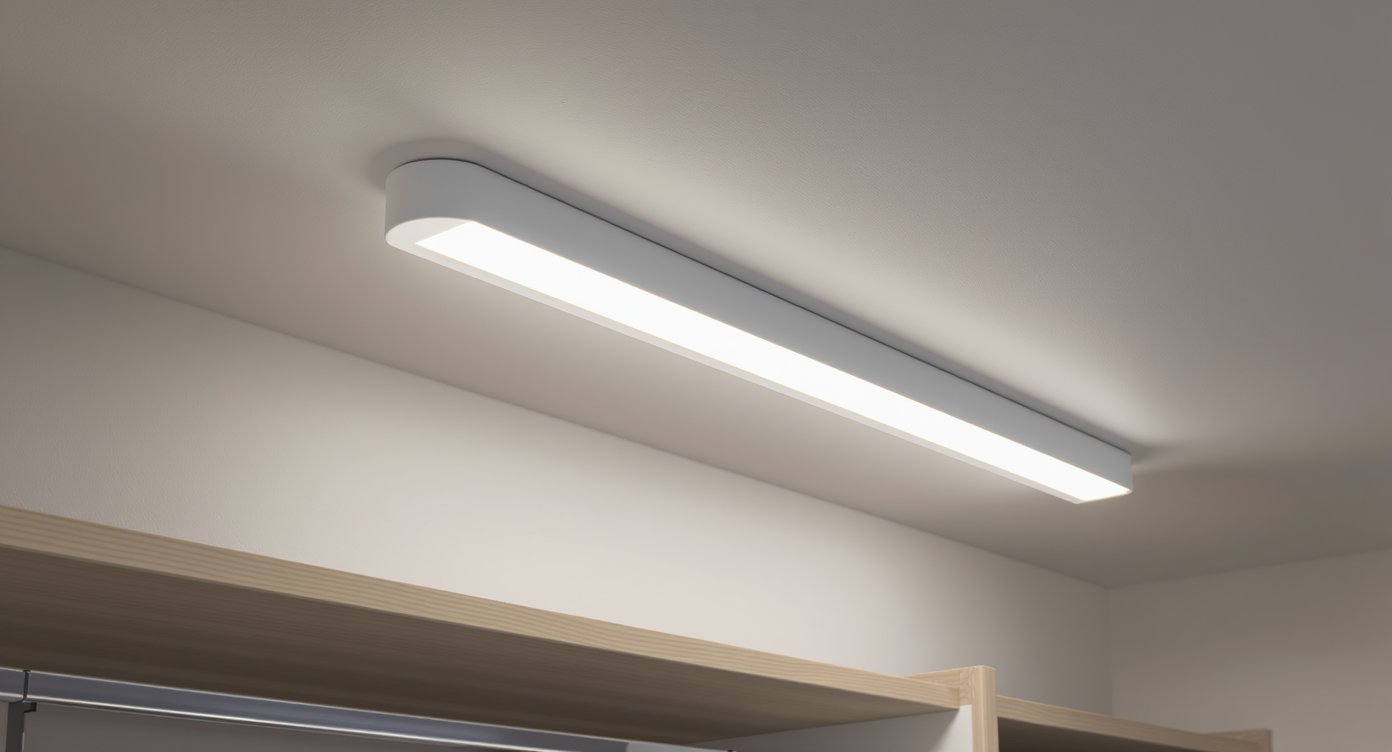
You’ll find that LED and fluorescent fixtures meet NEC safety standards primarily because they’re classified as non-hot lighting sources, generating minimal heat compared to incandescent alternatives. This lower heat emission directly reduces fire risk in enclosed storage spaces where combustible materials like clothing and boxes are stored. Furthermore, these fixtures provide superior energy efficiency and extended lifespans, LEDs last up to four times longer than traditional bulbs, which translates to reduced maintenance requirements and lower operating costs while maintaining code compliance.
Lower Heat Emission Advantage
When selecting closet lighting, heat emission becomes a critical safety factor that directly impacts fire risk and code compliance. LED and fluorescent fixtures provide cooler closet temperatures by operating below 140°F and 160°F, respectively, compared to incandescent lamps that reach 300–500°F. This temperature difference delivers reduced fire hazards when fixtures are near combustible materials like clothing and linens.
Code-compliant installations offer four key advantages:
- Reduced clearances – Surface-mounted LED/fluorescent fixtures require only 12″ spacing, with some closet-rated units needing 0″ clearance
- Safer proximity – Lower heat allows closer installation to storage items without ignition risk
- Burn prevention – Cooler surfaces protect users during bulb replacement
- NEC compliance – Fully enclosed LED/fluorescent luminaires meet NEC 410.16 requirements, while open incandescent fixtures remain prohibited
Energy Efficiency and Longevity
Beyond immediate safety considerations, LED and fluorescent fixtures deliver substantial energy savings that reduce operational costs while maintaining code-compliant closet illumination. LEDs consume approximately 75% less electricity than incandescent alternatives while providing lifespans exceeding 25,000–50,000 hours. Fluorescent lamps typically last 7,000–15,000 hours, greatly outlasting traditional bulbs. These extended operational periods enable maintenance frequency reduction in hard-to-reach closet installations where lamp replacement presents access challenges.
You’ll realize lifetime cost savings through decreased energy consumption and reduced replacement cycles. LED fixtures retain consistent output and color rendering throughout their service life, ensuring reliable illumination for clothing identification and storage tasks. Both technologies meet NEC energy efficiency standards while eliminating the fire hazards associated with high-wattage incandescent fixtures, making them the preferred choice for code-compliant, economically sound closet lighting solutions.
Closet-Rated Fixture Identification and Listing Verification
Since improper lighting in closets poses serious fire hazards, identifying genuinely closet-rated fixtures requires verification of specific certifications and compliance markings. The certification verification process begins with confirming UL listings under specific categories like IEUZ for fluorescent or IFAM for LED luminaires.
Verify closet fixture safety through UL database certification checks and specific compliance markings like IEUZ or IFAM categories before installation.
You’ll need to verify compliance through these critical steps:
- Check UL Product iQ database for your fixture’s certification status and third-party testing requirements
- Confirm UL 2108 and UL 1598 standards appear on the product listing
- Review installation instructions for explicit “suitable for closet storage spaces” language
- Verify NEC Section 410.16 compliance in manufacturer documentation
These fixtures undergo rigorous temperature testing with glass fiber insulation batting, simulating direct contact with clothing while ensuring safe operational temperatures.
Proper Placement and Mounting Techniques for Closet Lights
Correct fixture placement directly determines whether your closet lighting installation meets National Electrical Code (NEC) Section 410.16 requirements while maintaining adequate fire safety clearances. You must position surface-mounted fixtures with a minimum 12-inch clearance from stored items, while recessed fixtures require 6 inches. Center ceiling-mounted fixtures for uniform illumination in standard closets; use multiple fixtures or strip lights in long, narrow spaces to eliminate shadows.
For sensor positioning, install motion detectors at the entrance or upper corner where hanging clothes won’t obstruct detection. Wall switch accessibility requires placement near the closet entrance for convenient operation. Door-activated ball switches mount directly in the doorjamb. Always account for shelving, rods, and organizers when positioning fixtures to prevent shadow casting. Select adjustable or directional lighting for irregular closet shapes requiring focused illumination.
Professional Installation and Code Compliance Verification
While proper fixture placement establishes the physical foundation for safe closet lighting, your installation must satisfy National Electrical Code requirements and pass mandatory inspections to operate legally. The professional approval process demands:
- Qualified electrician installation guaranteeing NEC Article 410 compliance, proper load calculations, and wire gauge verification
- Fixture documentation submission, including UL closet ratings and manufacturer spec sheets to your local Authority Having Jurisdiction
- Final inspection verification of clearances (12 inches for surface-mounted LED/incandescent; 6 inches for recessed), wiring techniques, and junction box access
- Permit and sign-off records retained for insurance and resale purposes
Among homeowner responsibilities, you’ll maintain inspector-approved documentation and confirm any deficiencies are corrected before legal circuit use. Only fully enclosed, specifically listed luminaires pass code verification.
Frequently Asked Questions
Can I Install a Dimmer Switch for My Closet Lighting?
You can install a dimmer switch for closet lighting if you meet NEC section 410.16 requirements. Your fixtures must have fully enclosed bulbs with proper clearance, 12 inches for surface-mount or 6 inches for recessed lighting options. Guarantee your dimmer’s compatible with your bulb type (LED-rated for LEDs) and matches circuit voltage. Consider fixtures with integrated switches as alternatives. Always verify your dimmer’s wattage rating exceeds your total load, and follow manufacturer instructions for code-compliant installation.
Are Battery-Operated Stick-On Lights Code Compliant for Closets?
Battery-operated stick-on lights aren’t typically code-compliant for permanent closet installations since NEC 410.16 requires hardwired, closet-rated fixtures. However, you can use them as supplemental lighting alongside code-compliant hardwired solutions. Motion sensing closet lights and sensor activated lights with LED technology offer safe, low-heat operation when UL-listed. For permanent compliance, install enclosed hardwired fixtures meeting NEC clearance requirements. Always verify your local Authority Having Jurisdiction’s interpretation before relying solely on battery-powered options.
Do Walk-In Closets Have Different Lighting Requirements Than Reach-In Closets?
No, walk-in and reach-in closets don’t have different NEC lighting requirements, both follow the same fixture clearance rules and enclosed-lamp standards. However, walk-ins over 50 sq. ft. typically need ceiling fixtures with wall switches for adequate illumination, while smaller reach-ins may use battery-operated lights. Regardless of size, you’ll maintain proper ventilation by avoiding heat-generating fixtures and guarantee safety through fully enclosed, closet-rated luminaires with correct clearances from stored items.
Can I Use Smart Bulbs in My Closet Fixtures?
You can use smart bulbs in closet fixtures if they’re LED-based, installed in completely enclosed luminaires, and meet NEC clearance requirements (12 inches for surface-mounted, 6 inches for recessed). Verify the manufacturer confirms enclosed-fixture compatibility. Compatible smart bulb features like motion sensors and auto-shutoff augment safety while improving energy efficiency considerations through reduced runtime. You must maintain proper fixture enclosure and spacing, smart technology doesn’t override code requirements. Avoid using smart bulbs in bare, pendant, or pull-chain installations.
Are There Wattage Limits for Bulbs in Closet Fixtures?
Yes, you’re limited by your fixture’s maximum rated wattage; never exceed it, regardless of bulb brightness levels. The NEC doesn’t set universal wattage caps; instead, manufacturers specify limits based on heat dissipation and enclosure design. Proper lighting installation methods require checking fixture labels before selecting bulbs. LED options typically allow lower wattages while delivering adequate illumination. Always match bulb wattage to the fixture’s rating to prevent overheating, guarantee code compliance, and maintain safe closet operation.
